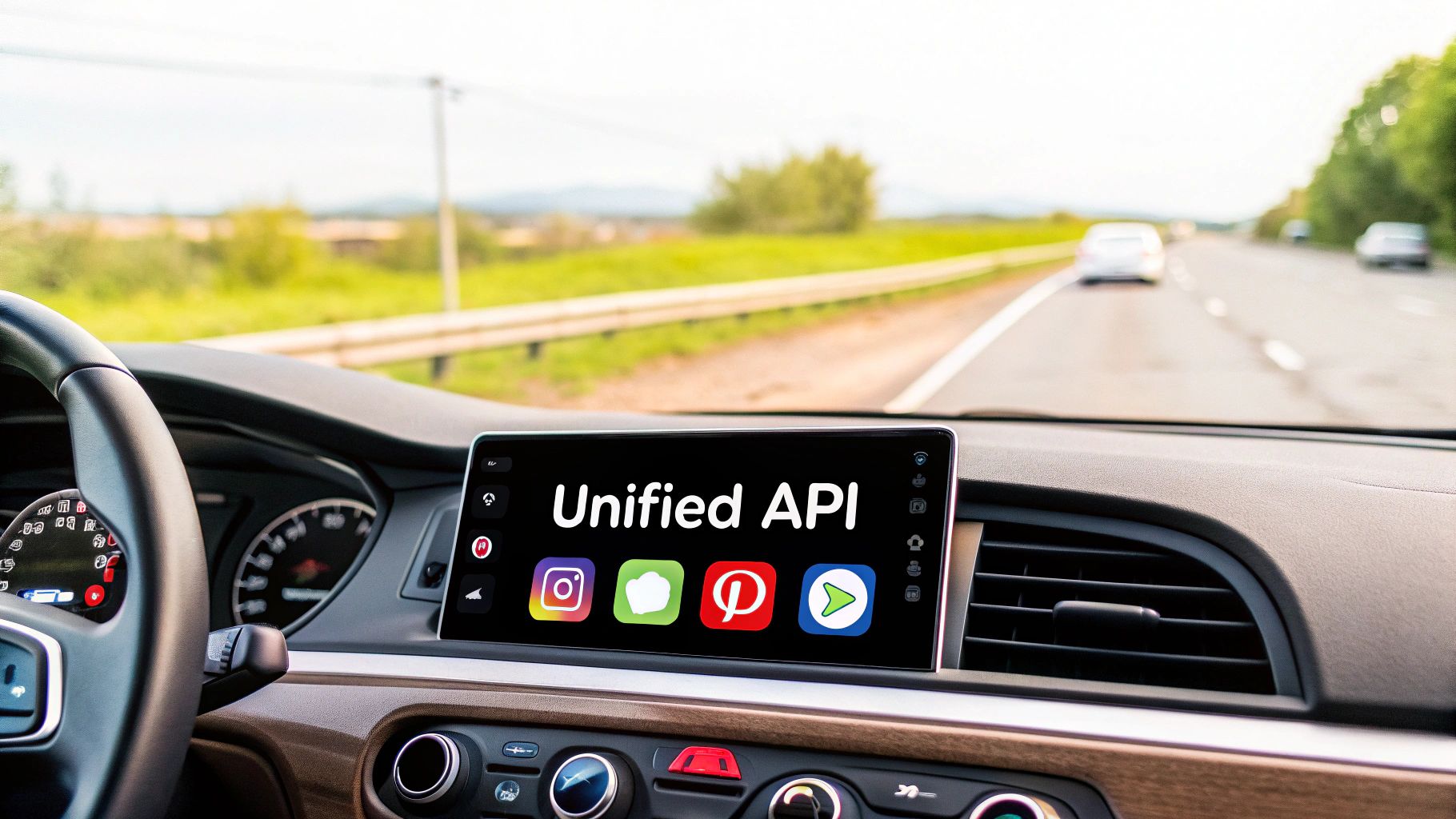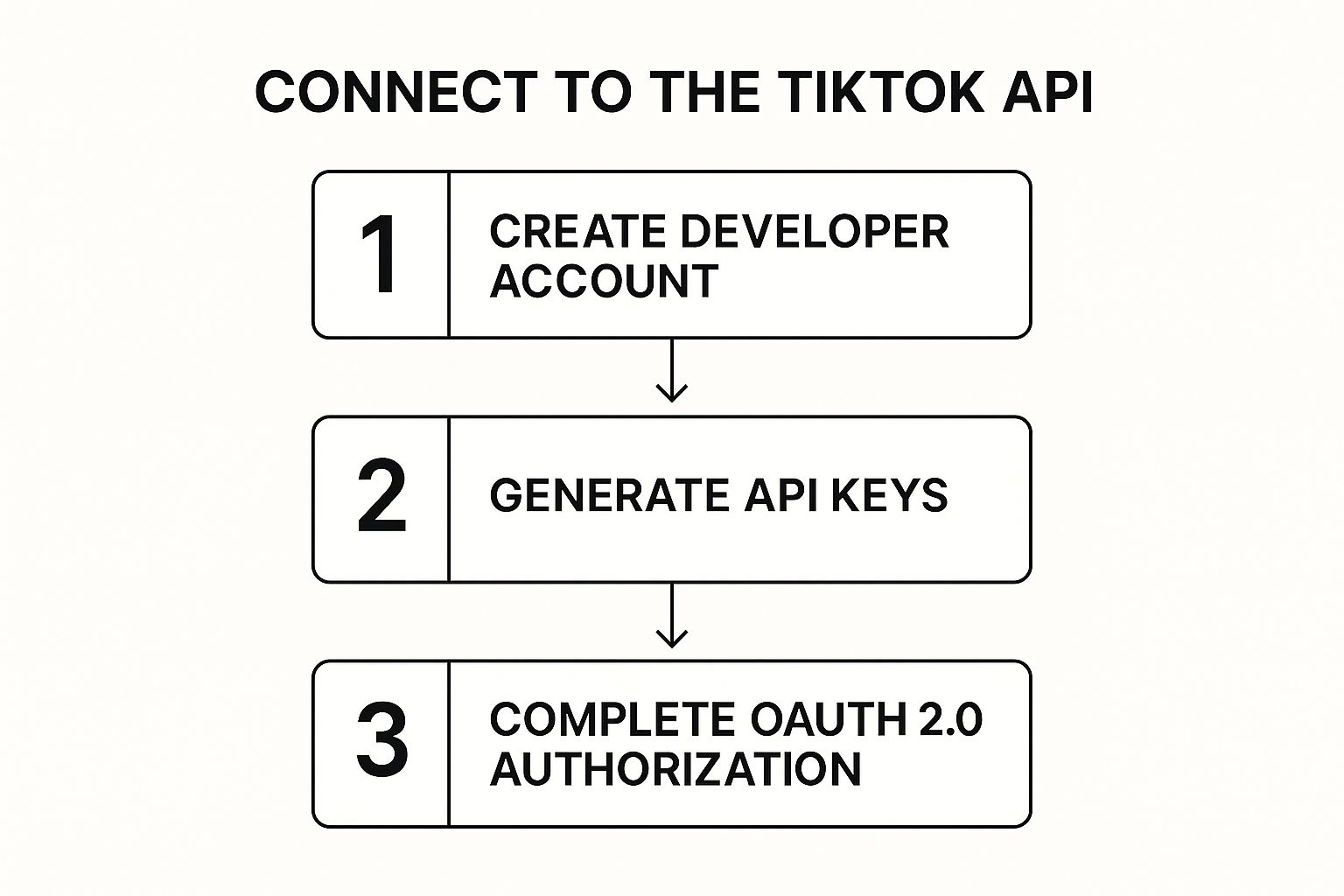Trying to keep up with TikTok's relentless pace by hand is a losing game. It’s like trying to catch rain in a bucket during a downpour—you'll get a few drops, but most of the opportunity slips right by. A TikTok posting API is the only practical way to automate your entire workflow, shifting you from frantic manual uploads to a scalable, efficient content pipeline. It's the technical backbone every serious creator or brand needs for consistent growth.
Why Manual TikTok Management Is Holding You Back
If you’re still downloading, uploading, and scheduling every single TikTok video manually, you're putting yourself at a massive disadvantage. This tedious grind doesn’t just burn through your time; it actively kneecaps your ability to scale and stay relevant on a platform that moves at the speed of light.
Every minute you spend wrestling with the upload button is a minute you aren't spending creating your next viral hit.

This bottleneck only gets worse as your account grows. Manual processes create friction, leading to inconsistent posting schedules, missed opportunities during peak engagement hours, and chaotic team collaboration. For agencies juggling multiple client accounts, the problem multiplies, making it nearly impossible to maintain a high-quality, consistent presence across the board.
The True Cost of Inefficiency
The real cost here isn't just wasted hours. It's the missed engagement from failing to post at the perfect moment. It's the creative burnout from focusing on logistics instead of fresh ideas. This is where programmatic access through an API becomes a non-negotiable tool.
By early 2025, TikTok had already blown past 1.6 billion monthly active users globally, with the average person spending about 58 minutes a day on the app. You can't tap into that massive, engaged audience with a strategy that relies on manual labor. It just won't work.
Shifting to an Automated Workflow
A TikTok posting API completely changes how you operate. You stop being a content administrator and start being a content strategist. That shift is everything for anyone serious about using the platform for growth.
Here’s what you immediately gain by ditching the manual grind:
- Consistency: Automatically schedule posts for optimal times without having to be online.
- Scalability: Manage dozens of accounts or a high volume of content without the logistical nightmare.
- Efficiency: Free up your most valuable resource—time—to focus on what actually moves the needle: creating great videos.
While TikTok offers its own developer tools, a unified API like Late can provide a much more direct path. It streamlines the entire process, letting you connect and automate not just TikTok but all your other platforms through a single, clean integration. To get there, you'll want to lean on the right Essential Social Media Content Creation Tools to build a powerful content engine.
You can also check out our detailed guide on how to automate social media posting across all your channels.
Choosing a Unified API Over Direct Integration
So, using a TikTok posting API is a no-brainer compared to manual uploads. But that leads to the next big question: which API should you use?
Your first instinct might be to go straight to the source and integrate with TikTok’s official Content Posting API. On the surface, it seems logical. But take it from someone who's been down this road—it’s a path riddled with platform-specific quirks and documentation rabbit holes that can bring your development to a screeching halt.
When you integrate directly, you're tying your entire system to one platform's ecosystem. Every social network has its own way of doing things—unique authentication flows, cryptic error codes, and fussy media requirements. Building a solid connection to TikTok is one huge project. Now, imagine you want to add Instagram, LinkedIn, or Facebook. You’re essentially starting from scratch every single time. It's a maintenance nightmare waiting to happen.

This is precisely where a unified API, like the one offered by Late, presents a powerful alternative. It acts as an abstraction layer, shielding you from the maddening complexities of each individual platform.
The Power of a Single Connection
Instead of trying to manage a tangled mess of different integrations, a unified API gives you one consistent, predictable set of rules. Think about it: a single authentication workflow and standardized endpoints that just work for TikTok, Instagram, Twitter, and every other platform you need to support. This approach doesn't just cut down on initial development time; it makes long-term maintenance infinitely simpler.
This isn’t just about convenience—it’s a massive strategic advantage. Your team can pour its energy into building killer user-facing features instead of losing weeks deciphering the subtle nuances of yet another social network's API. A single, well-documented integration is far easier to manage, debug, and scale.
A unified API means you write the code once and deploy it everywhere. It eliminates redundant engineering work and allows you to add new social platforms to your application in hours, not weeks.
If you’re building social media tools, marketing automation software, or dashboards for agency clients, this is an alternative that makes a lot of sense. You get speed, reliability, and the agility to adapt as your product grows. If you want to go deeper, we've written more about the benefits of a unified social posting API and how it makes cross-platform management a breeze.
Comparing Direct vs. Unified APIs
Ultimately, the choice comes down to where you want to invest your most valuable resource: your team's time. Do you want them to become experts in the nitty-gritty of every social media API, or do you want them focused on building your product?
Here’s a quick breakdown of what you're choosing between:
| Feature | Direct Integration (TikTok API) | Unified Integration (Late API) |
|---|---|---|
| Development Time | High; requires a separate build for each platform. | Low; a single integration covers all platforms. |
| Maintenance | Complex; you have to track API updates for every network. | Simple; maintenance is handled for you by the provider. |
| Consistency | Inconsistent; different endpoints, error codes, and logic. | Standardized; predictable endpoints and responses. |
| Scalability | Slow; adding a new platform is a major project. | Fast; easily plug in new social networks as needed. |
Connecting to the TikTok API in Minutes
Before you can automate a single post, you need to establish a secure, authenticated connection with TikTok. This is the first real step. Diving into OAuth 2.0 flows and managing API keys might sound like a headache, but a unified solution like the Late API can boil it all down to a few straightforward steps.
The idea is simple: get your app talking to TikTok securely so you can focus on the cool part—actually posting content. This connection is what lets your application act on a user's behalf, making it the bedrock of any tool you build.
This infographic breaks down the three main stages you'll go through to get connected.

Think of it as a roadmap: from initial setup to the final digital handshake that gives your app access.
Getting a Handle on the Authentication Flow
At its core, authentication is just a permissions request. You’re asking a TikTok user, "Can my app post videos for you?" The industry standard for this is the OAuth 2.0 protocol, which ensures the user's login details are never actually shared with your application. It’s all about security.
Instead of a password, your application gets a temporary, secure access token. This token is like a short-term key that proves your app has permission to make calls to the TikTok posting API for that user.
Since TikTok opened up its Posting API for broader use in late 2022, we’ve seen a huge jump in developers building smarter content management tools. This API is what allows creators to schedule posts and pull performance data, helping them make better decisions to drive engagement. You can learn more about TikTok's evolving ecosystem and trends to see just how big of a deal this was.
Generating Your API Credentials
First things first, your application needs its own set of unique identifiers. This is where your API keys—usually a Client ID and a Client Secret—come in. They're essentially your app's username and password for talking to the API.
You'll generate these from your developer dashboard. It is absolutely crucial to keep your Client Secret under lock and key. Store it as an environment variable and never, ever expose it in client-side code like a browser.
Treat your
Client Secretlike your most important password. If it leaks, a bad actor could impersonate your application, which could lead to a serious security mess.
From Authorization Code to Access Token
The last piece of the puzzle is turning an authorization code into an access token. It works like this: after a user grants your app permission, they're redirected back to your app with a temporary code. Your server then makes a secure, backend request to the API provider, sending along your Client Secret to swap this code for a real access token.
Here’s a quick breakdown of that exchange:
- User Grants Consent: The user clicks "Authorize," and TikTok sends them back to your specified redirect URI.
- Receive Auth Code: Your application grabs the temporary authorization code from that redirect URL.
- Request Access Token: Your backend server sends the code, your
Client ID, and yourClient Secretto the API's token endpoint. - Store the Token: The API validates everything and sends back an access token and a refresh token. You’ll need to store these securely to make future API calls.
Once you have a valid token, you're officially connected. You're ready to start uploading and scheduling videos.
Alright, once you've handled authentication, it's time for the fun part: actually uploading and scheduling your TikTok videos through code. This is where you really see the magic of a good TikTok posting API. What was once a manual, phone-tapping chore can become a slick, automated part of your application's workflow.
With a unified API like Late, the whole process is broken down into a few logical steps that are surprisingly easy to wire up.
The general idea is to first tell the API you're about to send a video, then actually push the file up, and finally, publish it with your caption and settings. This multi-stage process is pretty standard for large media uploads and makes the whole thing much more reliable.
Kicking Off the Video Upload
Your first API call is essentially to say, "Hey, I've got a video coming your way." Think of it like reserving a spot for your content before sending the bytes. You'll make a POST request to an endpoint like /posts/initiate-upload, telling it which social media profile you're targeting.
In response, the API will hand you back a unique upload_id and a secure, pre-signed URL. This URL is a temporary, direct link for your video file. It’s a smart and secure way to handle the transfer, as it offloads the heavy lifting directly to a dedicated storage service.
Sending the Actual Video File
Now that you have your pre-signed URL, you can upload the video. This is usually a simple PUT request made directly to that unique URL you just received. The body of this request is just the raw video file. No extra fuss.
Before you send it, though, make sure your video file meets TikTok's rules to avoid frustrating errors:
- File Type: Stick to the basics like MP4 or MOV.
- File Size: Don't go over 1GB.
- Duration: Your video needs to be between 3 seconds and 10 minutes long.
- Dimensions: It has to be at least 360px in both height and width.
My Advice: Build validation for these rules directly into your app before you even think about calling the API. Checking the file format, size, and duration on your end first will save you from a world of common API errors and lead to a much cleaner user experience.
Publishing or Scheduling Your Masterpiece
Once your video is safely uploaded, the final step is to make it live. You'll make one more POST request, this time to a general /posts endpoint. Here, you'll reference the upload_id from the first step and pack in all the metadata for your TikTok—the caption, privacy settings, you name it.
And this is where the real power move comes in: scheduling. By simply including a scheduled_for parameter with a future ISO 8601 timestamp, you can queue your video to post at the perfect moment. This is an absolute game-changer for building out content calendars and hitting those peak engagement windows without having to be glued to your screen.
Automating this is practically a necessity now. With some estimates suggesting nearly 34 million videos are uploaded to TikTok daily as of 2025, a programmatic approach is the only way to stay competitive. This is what allows social media management tools to schedule posts and juggle multiple accounts, helping brands hit their audience at just the right time. You can dig into more of these stats over at DataReportal's deep dive into TikTok.
For developers building social media tools, here's a quick look at the endpoints you'll be working with.
Late API Endpoint Comparison for TikTok
Here’s a quick reference for the primary endpoints used to manage TikTok video posts via the Late unified API.
| Endpoint | HTTP Method | Primary Function |
|---|---|---|
/posts/initiate-upload | POST | Starts the upload process and returns a pre-signed upload URL. |
[pre-signed-url] | PUT | Uploads the raw video file directly to the provided URL. |
/posts | POST | Publishes or schedules the uploaded video with all its metadata. |
These three endpoints form the core workflow for getting your video content onto TikTok programmatically.
The ability to schedule content reliably transforms your application from a simple posting tool into a strategic content planner, something manual uploads can never quite match.
Building a Resilient API Integration
Getting a successful 200 OK from your first API call feels great, but it's just the starting line. To build a real, production-ready application that your users can actually depend on, you need to think about resilience from day one. A solid integration is one that expects the unexpected—things like expired tokens, failed uploads, or a user suddenly revoking permissions.
Without smart error handling, these small hiccups can easily crash your app or create a nightmare user experience. The goal isn't just to make it work; it's to build a system that can take a punch, recover on its own, and keep humming along smoothly.

A production-grade app doesn’t just work on a sunny day. It performs reliably when things get messy. That's the core idea behind building an integration that can handle the chaos of the real world.
Proactive Error Handling and Prevention
One of the most common failure points I see in any API integration is sloppy token management. Access tokens will expire—that's a feature, not a bug—and it's your job to handle it so seamlessly your user never notices.
When you first get an access token, you should also get a refresh token. Store both of these securely, preferably in an encrypted database. The pro move here is to build an automated refresh cycle. Before making an API call, just check if the access token is about to expire. If it is, use the refresh token to silently grab a new one in the background. Your users will never even see an authentication error.
Building a resilient system is about anticipating failure. Implement retry logic with exponential backoff for temporary network issues and design a seamless token refresh flow from day one. Don't treat these as afterthoughts.
You also have to be mindful of API rate limits. Every API, including TikTok's, puts a cap on how many requests you can fire off in a set period. If you blow past those limits, your app will get temporarily blocked, causing service disruptions.
- Track Your Usage: Keep an eye on the
X-RateLimitheaders in the API response. They tell you your current limit and how many calls you have left. - Implement Throttling: If you see you're getting close to the limit, your code should be smart enough to slow down or queue outgoing requests.
- Use Webhooks: Whenever you can, use webhooks to get updates pushed to you instead of constantly polling the API for changes. It's way more efficient.
Nailing rate limit management is non-negotiable for a stable app. For a deeper dive, check out our guide on API rate limit best practices.
Designing for Downtime and Failures
Let's be real: even the most reliable APIs have moments of downtime. Your application needs to be designed to handle these situations without just giving up. If a video upload fails, for example, don't just throw the post away.
A much better approach is to implement a queueing system. If a post fails to upload because of an API error or a brief outage, your system can automatically pop it into a queue. Then, it can retry the upload later once things are back to normal. This simple practice ensures no content gets lost and creates a far more dependable service for your users. It's details like this that separate a fragile script from a truly professional application.
Frequently Asked Questions
Anytime you're working with a TikTok posting API, the same questions tend to pop up. Trust me, I've been there. Getting these sorted out early saves you a ton of time trying to debug weird issues down the road. Let's walk through some of the most common things developers run into.
Right off the bat, developers usually ask if they can post things other than standard videos, like those multi-image carousels. While the native TikTok app handles this format just fine, API capabilities often lag behind. Most APIs, including unified ones, are laser-focused on what TikTok is known for: single video uploads. Your best bet is to always check the API's documentation for currently supported media types before you start building.
Understanding API Limitations
Another big area of confusion is about the creative features inside the TikTok app. Can you slap on that trending audio, add some stickers, or run a poll directly through an API call?
The short answer is no. Due to restrictions in how the API is designed, you cannot access TikTok's native library of sounds, music, stickers, or interactive elements like polls. Those are in-app exclusives. If those elements are a must-have for your content, your workflow needs to account for this. You'd prepare the video with all the creative bells and whistles first, save the final file, and then upload that finished video via the API.
The core function of a posting API is to automate the upload and scheduling of a finished video file. It doesn't replicate the in-app creative editing suite.
Getting your posts rejected is no fun, and it's almost always because the content doesn't meet TikTok's technical rules. Pushing something that violates their specs is probably the number one reason API calls fail.
Here are the hard limits you need to build your validation around:
- Daily Post Limit: TikTok is pretty generous, allowing up to 25 posts per account in a 24-hour period through the API.
- Character Limit: Your caption, including all the spaces and hashtags, can't exceed 2,200 characters.
- Video Length: Your video has to be at least 3 seconds long but no more than 10 minutes.
Best Practices for Post Management
Finally, a common question is about what happens after a post goes live. Can you edit a caption with a typo or delete a post programmatically? As of now, editing or deleting a TikTok post via the API isn't a standard feature. Once it's published, any changes have to be made manually in the TikTok app.
This makes it incredibly important to double-check everything—captions, hashtags, privacy settings—before you fire off that final API call. A smart move is to build a simple review step into your application's workflow. It’s a small bit of upfront effort that can prevent a lot of headaches from mistakes you can't fix with code later.
Ready to stop wrestling with individual social media APIs and start building faster? With Late, you can connect to TikTok and ten other major platforms through a single, reliable integration. Sign up for the Late unified scheduling API and get your first posts automated in minutes, not weeks.